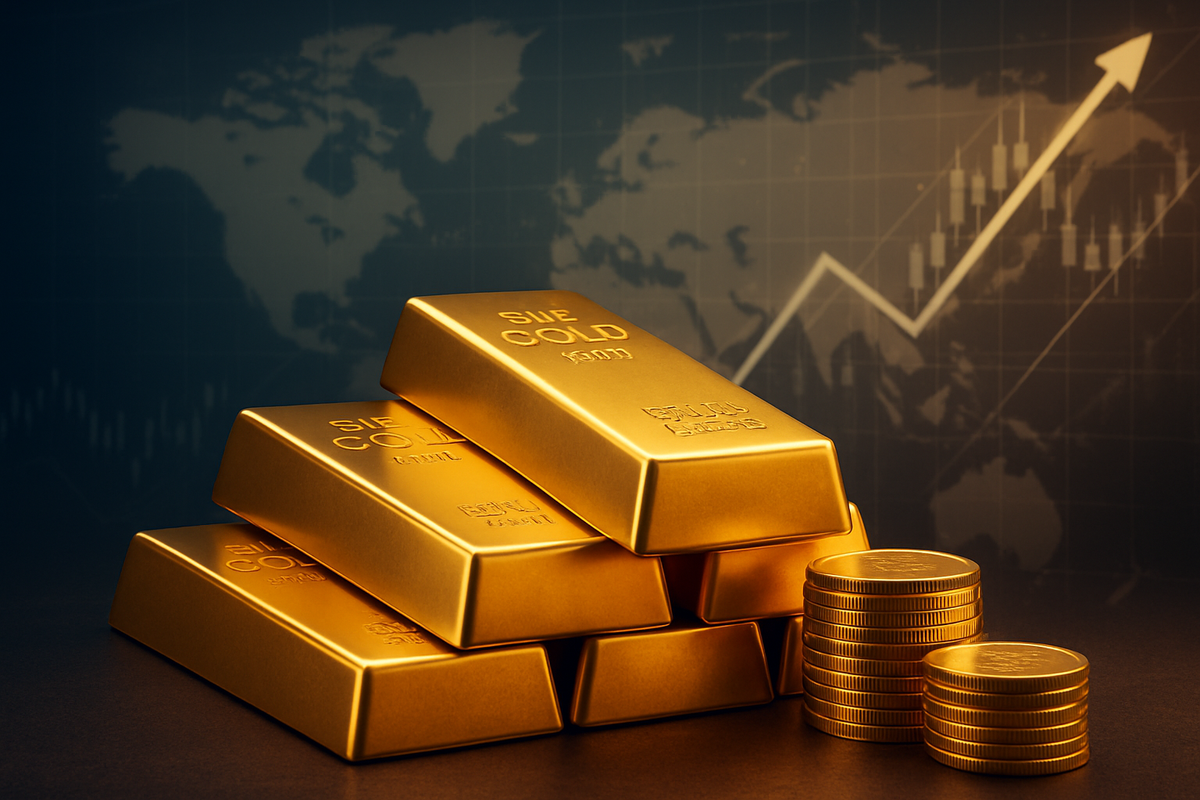
New York, NY – October 20, 2025 – Gold, the venerable safe-haven asset, has once again etched its name in the annals of financial history, surging to an unprecedented all-time high of approximately US$4,379.96 per ounce on October 16, 2025. As of today, October 20, 2025, the precious metal continues to trade near these elevated levels, reflecting a market gripped by profound uncertainty and a fervent flight to safety. This remarkable ascent underscores gold's enduring appeal as a bulwark against geopolitical turmoil, economic instability, and inflationary pressures, sending clear signals across global financial markets.
The immediate implications of this record-breaking performance are multifaceted. For investors, it highlights a deep-seated apprehension regarding the future trajectory of traditional assets and fiat currencies. For the broader economy, it signals a period of heightened caution, where capital is increasingly seeking tangible stores of value over riskier propositions. The sustained demand for gold is not merely a reaction but a strategic repositioning by institutional and retail investors alike, who are keenly observing the shifting sands of global power and economic paradigms.
The Golden Ascent: A Chronicle of Uncertainty
Gold's journey to its latest peak has been nothing short of spectacular, marking a significant milestone in a year characterized by relentless upward momentum. The metal first breached the psychological US$4,000 per ounce mark on October 8, 2025, and continued its meteoric rise, culminating in the US$4,379.96 per ounce record just days later. This latest surge represents the 45th new all-time high for gold this year, building on a previous significant milestone in April 2025 when prices touched approximately US$3,500 per ounce.
The drivers behind this golden rally are a complex web of interconnected global events. Persistent geopolitical tensions, including ongoing conflicts in the Middle East and Europe, alongside escalating trade disputes between economic giants like the United States and China, have fueled an intense demand for safe-haven assets. Concurrently, expectations and actual interest rate cuts by the US Federal Reserve, including a recent 25-basis point reduction with further cuts anticipated, have diminished the opportunity cost of holding non-yielding gold. A weakening US dollar, spurred by trade tariffs and lower interest rates, has also made dollar-denominated gold more attractive to international buyers.
Furthermore, lingering inflation concerns, despite some moderation, continue to position gold as a traditional hedge against the erosion of purchasing power. Global central banks have emerged as formidable buyers, accumulating vast quantities of gold at a historic pace, underscoring a strategic diversification away from dollar-denominated assets. This robust institutional demand, coupled with record inflows into physically backed gold Exchange Traded Funds (ETFs) and increased net long positions in COMEX futures from Western investors, paints a picture of widespread and deep-rooted bullish sentiment. Fears of an impending equity market correction, the risk of a US government shutdown, and general macroeconomic instability further propel investors towards gold's perceived security.
Cash-Rich Gold Producers Emerge as Market Darlings
In this environment of soaring gold prices, a particular segment of the market is drawing significant investor attention: gold producers with strong free cash flow. These companies are increasingly seen as prime beneficiaries, offering investors a leveraged and relatively secure way to capitalize on the precious metal's rally. The allure stems from their enhanced financial stability, operational efficiency, and capacity to deliver substantial shareholder returns.
Strong free cash flow is the "gold standard" for evaluating mining companies, reflecting genuine operational efficiency and profitability that is less susceptible to accounting manipulations. When gold prices surge, these producers experience an "operational leverage" effect; their revenues increase at a faster rate than their relatively fixed production costs, leading to disproportionately larger improvements in profitability and robust free cash flow generation. This financial health allows them to fortify their balance sheets, reduce debt, and build cash reserves, making them more resilient to future market fluctuations.
For shareholders, the benefits are clear and compelling. Cash-rich gold producers can fund organic growth initiatives, advance project pipelines, and make impactful acquisitions without diluting existing shareholders through constant equity raises. More importantly, with less debt and ample cash, these companies are well-positioned to return significant value to investors through higher dividends and robust share repurchase programs. This disciplined capital allocation, combined with the potential for valuation multiple expansion as investor confidence grows, offers a compelling investment thesis, providing leveraged exposure to gold's performance while also serving as a portfolio diversifier and inflation hedge. Major gold mining companies like Newmont Corporation (NYSE: NEM) and Barrick Gold Corporation (NYSE: GOLD), known for their disciplined operations and strong cash generation, are particularly well-positioned to capitalize on this trend.
Broader Implications and Historical Echoes
Gold's current surge is more than just a market anomaly; it is a profound indicator of shifting global paradigms. It reflects a collective loss of confidence in traditional financial systems and political stability, signaling a broader trend of de-dollarization as central banks globally diversify their reserves. The metal's outperformance in various currencies underscores waning faith in fiat money and its role as a critical hedge against currency volatility.
The ripple effects are felt across numerous sectors. While gold miners rejoice in increased profitability and expanded exploration budgets, the jewelry industry faces headwinds, with soaring prices leading to dampened consumer demand and a noticeable shift towards more affordable alternatives like silver and diamonds. Central banks remain steadfast buyers, providing a crucial floor for gold prices, while gold loan Non-Banking Financial Companies (NBFCs) benefit from the enhanced value of their collateral. Historically, gold has consistently proven its prowess during times of crisis. Its performance in the 1970s and 1980s amidst rampant inflation, during the dot-com bust of 2000, the 2008 financial crisis, and the COVID-19 pandemic of 2020, all serve as powerful precedents for its current role as a quintessential safe haven. Regulatory discussions may also intensify regarding transparency in gold trading and the potential long-term role of Central Bank Digital Currencies (CBDCs) as alternative stable assets.
The Path Ahead: Navigating the Golden Future
Looking ahead, the gold market is poised for continued dynamism, presenting both opportunities and challenges. In the short term, while bullish sentiment remains robust, the market is susceptible to corrections and consolidation after such a rapid ascent, potentially seeing pullbacks towards the US$3,500 range. Key drivers of short-term volatility will include upcoming US inflation data, shifts in the Federal Reserve's monetary policy rhetoric, and ongoing geopolitical developments.
However, the long-term outlook for gold remains overwhelmingly bullish. Many financial institutions project further appreciation, with forecasts ranging from US$4,000 to US$5,000 per ounce by 2026, and even more ambitious targets of US$6,000 to US$10,000 by 2030. This sustained optimism is underpinned by persistent geopolitical instability, continued record central bank accumulation, lingering inflation concerns, a weakening US dollar, and structural shifts in global demand. For gold producers, high prices will continue to boost profitability and cash flows, prompting strategic pivots towards increased investment in exploration and development, a focus on operational efficiency, and a renewed emphasis on shareholder returns through dividends and share buybacks.
Investors should closely monitor several key indicators in the coming months: the US Federal Reserve's policy decisions and inflation data, the evolution of global geopolitical conflicts, the strength of the US dollar, central bank gold purchasing activities, and trends in gold-backed ETF flows. While gold offers an effective hedge and diversification, experts recommend maintaining a diversified portfolio with a moderate allocation to gold (e.g., 5-15%). Long-term investors may consider systematic accumulation on dips, while tactical traders should employ strict risk management. The ongoing saga of gold's ascent underscores its critical role in a world grappling with profound economic and geopolitical transformations.
Conclusion: Gold's Enduring Legacy in a Turbulent World
Gold's recent surge to an all-time high is a definitive statement from the global financial markets: uncertainty reigns, and the timeless appeal of tangible assets as a store of value is stronger than ever. The precious metal is not just reacting to events; it is serving as a critical barometer of the deep-seated anxieties and strategic reorientations occurring across the globe.
Moving forward, while short-term volatility is to be expected, the fundamental drivers supporting gold's bullish trajectory appear firmly entrenched. The era of geopolitical flux, persistent inflationary pressures, and a global quest for currency diversification ensures that gold will remain a central fixture in investment portfolios. Investors should remain vigilant, observing central bank actions, macroeconomic indicators, and geopolitical developments, as these will continue to shape gold's path. In a world increasingly defined by turbulence, gold's enduring legacy as a sanctuary asset has been powerfully reaffirmed, making it an indispensable component for navigating the complexities of the coming months and years.
This content is intended for informational purposes only and is not financial advice





